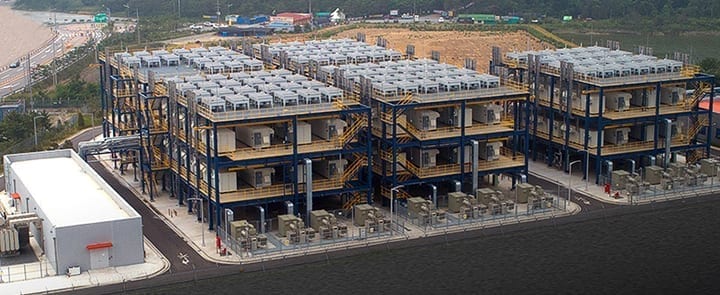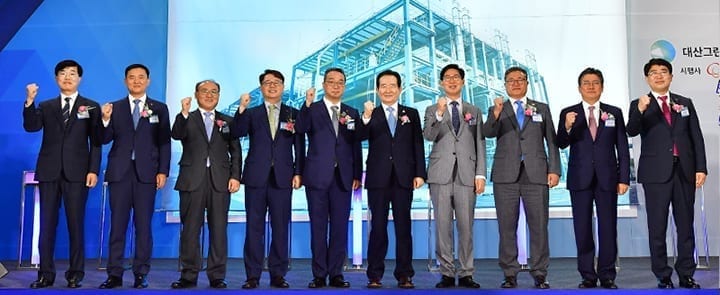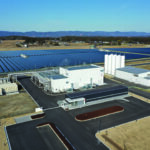The largest industrial hydrogen fuel cell power plant in the world and the first to use only hydrogen recycled from petrochemical manufacturing has been placed in service by Hanwha Energy at its Daesan Industrial Complex in Seosan, South Korea.
The innovative plant uses “recycled hydrogen from petrochemical manufacturing” supplied by the Hanwha Total Petrochemical plant located within the same complex. The company said the 50-MW power plant has the ability to generate up to 400,000 MWh of electricity annually, which it claimed is enough to power 160,000 South Korean homes.
“With the completion of this plant, we will help the government establish a roadmap to a hydrogen economy while boosting the local economy,” Hanwha Energy CEO In-Sub Jung said at an event celebrating the project’s completion.
How the Fuel Cell Power Plant Works
Hydrogen fuel cell energy differs greatly from fossil fuel electricity generation. Conventional fossil fuel technology relies on combustion to produce steam and spin a turbine. Hydrogen fuel cells, meanwhile, combine hydrogen and oxygen in an electrochemical reaction to generate electricity. The only byproducts from this reaction are heat and water vapor, making hydrogen fuel cells an appealing way to cut carbon emissions, according to Hanwha Energy.
The plant at the Daesan Industrial Complex contains 114 fuel cells. The Hanwha Total Petrochemical plant produces up to three tons of hydrogen per hour. The recycled hydrogen is pumped into the new power plant (Figure 1) via underground pipes and fed directly into the fuel cells. Electricity is then generated by the electrochemical reaction. No greenhouse gases, sulfur oxide (SOx), or nitrogen oxide (NOx) are emitted.

The Daesan hydrogen fuel cell power plant is a near-zero-waste operation, according to Hanwha Energy. The fuel cells generate up to 120,000 metric tons of water vapor per year as a byproduct. This vapor is condensed and pumped back to Hanwha Total Petrochemical. Highly efficient microfilters are installed on the fuel cells to make the plant even greener. These microfilters can catch particles smaller than 1 micrometer in width. They prevent pollutants including atmospheric dust from contaminating the electrochemical reaction that occurs in the fuel cells.
Within a fuel cell, hydrogen molecules are split into electrons and hydrogen ions to generate direct-current electricity. These electrons and hydrogen ions are then bound to oxygen to form water vapor that is expelled as exhaust. By removing impurities from oxygen before it enters the Daesan power plant’s fuel cells, the microfilters ensure optimal electricity generation while prolonging the cells’ lifespans.
A Vital Environmental Solution
The idea for the hydrogen fuel cell power plant project originated in 2015. Hanwha Total Petrochemical was faced with a dilemma. It had expanded its aromatic hydrocarbon production capacity at the Daesan Industrial Complex. Aromatic hydrocarbons are compounds made primarily of hydrogen and carbon atoms, and are used in a variety of applications such as the production of solvents, dyes, plastics, and medications.
However, the increased aromatic hydrocarbon production at the site resulted in excessive amounts of hydrogen byproduct. Normally, this hydrogen would be burned off, but the company had instituted a “No Combustion, No Air Pollution” policy to reduce its carbon emissions.
Hanwha Energy proposed recycling the hydrogen to produce electricity for Hanwha Total Petrochemical, which seemed like a win-win solution. In January 2018, Hanwha Energy partnered with Korea East-West Power and Doosan Corp. to establish Daesan Green Energy, a special-purpose company to facilitate the completion of a hydrogen fuel cell power plant project. Hanwha Energy is the largest shareholder (49%) and is responsible for the power plant’s day-to-day operations. Korea East-West Power (35%) purchases the renewable energy certificate produced by the plant, while Doosan (10%) supplies and maintains the hydrogen fuel cells. The remaining 6% stake in Daesan Green Energy is held by financial investors.
Daesan Green Energy was issued a generation business license in February 2018. Major contracts were signed and construction plans approved in April that year. Construction on the project began in July 2018.
The plant was constructed by Hanwha Engineering & Construction at a cost of $212 million. It occupies about 20,000 square meters of the Daesan Industrial Complex. The first power transmission occurred in July 2019, and the process of commissioning began at that time. Although commercial operation was said to have begun in June 2020, Hanwha Energy didn’t host a celebration (Figure 2) to recognize the completion of the plant until July 28, 2020, or officially announce the completion until August 7, 2020.

While Hanwha Energy says other attempts have been made to use recycled hydrogen to generate electricity, “they are all small-scale demonstrations that produced less than 1 MW of power.” It said the Daesan hydrogen fuel cell power plant is the first to mass-produce electricity with hydrogen only. “This ground-breaking model for electricity generation is attracting attention from industrial-plant operators in Korea, China, India, and the U.S.,” the company said.
—Aaron Larson is POWER’s executive editor (@AaronL_Power, @POWERmagazine).









